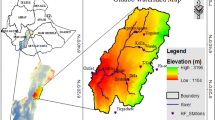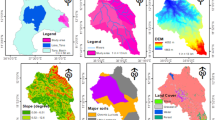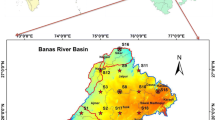Abstract
In this study, modeling of temporal trends for commonly climatic variables for the base line period and future time interval was undertaken for Gelgel Belese watershed in Upper Blue Nile Basin, Ethiopia. The climatic variables data from the period 1998 to 2019 was considered the baseline period and the future climate variables data were downscaled using dynamic downscaling method from the Coordinated Regional Climate Downscaling Experiment over the African Domain for 2020 to 2100. Mann–Kendall’s trend test and time series linear model were used to test the temporal trends of climatic variables in the study area. The test result of observed precipitation indicated non-significant trend, while the average annual temperature indicated an increasing trend with the rate changes of 0.0067 \(^\circ{\rm C}\)/year and 0.005 ℃/year in Dangila and Chagni stations, respectively. Whereas, in the same time interval non-significant increasing trend in average annual temperature in Pawi station was common. In line with average annual temperature, evapotranspiration indicated significant increasing trend with the rate change of 0.68 mm/5 year in Dangila station and non-significant increasing trend in Chagni and Pawi stations. Future average annual temperature and annual evapotranspiration imply significant increasing trend, whereas mean annual future precipitation exhibited non-significant decreasing trend in the majority of the RCPs in all stations in the future time interval. This change may be responsible for alterations of the hydrological cycle in the study area. Higher increment of temperature and evapotranspiration and reduction of rainfall in the future over the study watershed may result in decreasing pattern of total flow of the river in the area. Due to this, water demand dissatisfaction for different water users in the study area may become common event. Thus, the designs of different water harvesting infrastructures for different water users should be taken into account in the study area in the future.









Similar content being viewed by others
Data availability
All the original data and materials of this research are available in Ethiopian National Meteorological Agency. The original and the manipulated data can also be found in the hand of the corresponding authors of this research.
Code availability
Not applicable.
Change history
16 December 2023
A Correction to this paper has been published: https://doi.org/10.1007/s00704-023-04803-8
References
Abtew W, Melesse A, Abtew W, Melesse A (2013) Climate change and evapotranspiration. Evaporation Evapotranspiration: Meas Estimations 197–202
Ahmed KF, Wang G, Silander J, Wilson AM, Allen JM, Horton R, Anyah R (2013) Statistical downscaling and bias correction of climate model outputs for climate change impact assessment in the US northeast. Global Planet Chang 100:320–332
Anderson NJ (2000) Diatoms, temperature and climatic change. Eur J Phycol 35(4):307–314
Bank TW (2006) Managing water resources to maximize sustainable growth: a country water resources assistance strategy for Ethiopia. In: The World Bank Washington, DC
Bekele AA (2017) Evaluating the impact of climate change on surface water resources for estimating crop water demand: a case study of Birr Watershed, Ethiopia
Bewket W, Conway D (2007) A note on the temporal and spatial variability of rainfall in the drought-prone Amhara region of Ethiopia. Int J Climatol: J R Meteorol Soc 27(11):1467–1477
Change IPOC (2014) Ipcc. Climate change
CHANGE EPOC (2015) First Assessment Report Working Group II-Climate change impact, vulnerability, adaptation and mitigation V. In: ETHIOPIAN ACADEMY OF SCIENCES
Cheung WH, Senay GB, Singh A (2008) Trends and spatial distribution of annual and seasonal rainfall in Ethiopia. Int J Climatol: J R Meteorol Soc 28(13):1723–1734
Daba M, Rao GN (2016) Evaluating potential impacts of climate change on hydro-meteorological variables in Upper Blue Nile Basin, Ethiopia: a case study of Finchaa Sub-basin. J Environ Earth Sci 6(5):48–57
Daba MH, Ayele GT, You S (2020) Long-term homogeneity and trends of hydroclimatic variables in Upper Awash River Basin, Ethiopia. Adv Meteorol 2020:1–21
Dile et al (2013) Hydrological response to climate change for gilgel abay river, in the lake tana basin-upper blue Nile basin of Ethiopia. PLoS one 8(10):e79296
Dile YT, Srinivasan R (2014) Evaluation of CFSR climate data for hydrologic prediction in data-scarce watersheds: an application in the Blue Nile River Basin. JAWRA J Am Water Resour Assoc 50(5):1226–1241
Franke JA, Müller C, Elliott J, Ruane AC, Jägermeyr J, Balkovic J, Ciais P, Dury M, Falloon PD, Folberth C (2020) The GGCMI Phase 2 experiment: global gridded crop model simulations under uniform changes in CO 2, temperature, water, and nitrogen levels (protocol version 1.0). Geosci Model Dev 13(5):2315–2336
Gajbhiye S, Meshram C, Mirabbasi R, Sharma S (2016) Trend analysis of rainfall time series for Sindh river basin in India. Theoret Appl Climatol 125:593–608
Gedefaw M, Yan D, Wang H, Qin T, Girma A, Abiyu A, Batsuren D (2018) Innovative trend analysis of annual and seasonal rainfall variability in Amhara regional state, Ethiopia. Atmosphere 9(9):326
Gu X, Zhang Q, Singh VP, Shi P (2017) Changes in magnitude and frequency of heavy precipitation across China and its potential links to summer temperature. J Hydrol 547:718–731
Hargreaves GH, Samani ZA (1985) Reference crop evapotranspiration from temperature. Appl Eng Agric 1(2):96–99
Kang Y, Khan S, Ma X (2009) Climate change impacts on crop yield, crop water productivity and food security–a review. Prog Nat Sci 19(12):1665–1674
Karpouzos D, Kavalieratou S, Babajimopoulos C (2010) Trend analysis of precipitation data in Pieria Region (Greece). Eur Water 30(30):30–40
Kendall K (1975) Thin-film peeling-the elastic term. J Phys D: Appl Phys 8(13):1449
Kiya K (2018) Assessing climate change impacts on water availability in Upper Awash Sub-Basin, Ethiopia ASTU]
Kundu S, Khare D, Mondal A (2017) Interrelationship of rainfall, temperature and reference evapotranspiration trends and their net response to the climate change in Central India. Theoret Appl Climatol 130:879–900
Malede DA, Agumassie TA, Kosgei JR, Linh NTT, Andualem TG (2022) Analysis of rainfall and streamflow trend and variability over Birr River watershed, Abbay basin, Ethiopia. Environ Chall 7:100528
Mann HB (1945) Nonparametric tests against trend. Econometrica: J Econ Soci 245–259
Mavromatis T, Stathis D (2011) Response of the water balance in Greece to temperature and precipitation trends. Theoret Appl Climatol 104(1–2):13–24
Melke A, Abegaz F (2017) Impact of climate change on hydrological responses of Gumara catchment, in the Lake Tana Basin-Upper Blue Nile Basin of Ethiopia. Int J Water Resour Environ Eng 9(1):8–21
Mengistu D, Bewket W, Dosio A, Panitz H-J (2021) Climate change impacts on water resources in the upper blue nile (Abay) river basin, ethiopia. J Hydrol 592:125614
Mengistu D, Bewket W, Lal R (2014) Recent spatiotemporal temperature and rainfall variability and trends over the Upper Blue Nile River Basin, Ethiopia. Int J Climatol 34(7):2278–2292
Mohammed JA, Gashaw T, Tefera GW, Dile YT, Worqlul AW, Addisu S (2022) Changes in observed rainfall and temperature extremes in the Upper Blue Nile Basin of Ethiopia. Weather Clim Extremes 37:100468
Mondal A, Kundu S, Mukhopadhyay A (2012) Rainfall trend analysis by Mann-Kendall test: a case study of north-eastern part of Cuttack district, Orissa. Int J Geol Earth Environ Sci 2(1):70–78
Motiee H, McBean E (2009) An assessment of long-term trends in hydrologic components and implications for water levels in Lake Superior. Hydrol Res 40(6):564–579
Muerth M, Gauvin St-Denis B, Ricard S, Velázquez J, Schmid J, Minville M, Caya D, Chaumont D, Ludwig R, Turcotte R (2013) On the need for bias correction in regional climate scenarios to assess climate change impacts on river runoff. Hydrol Earth Syst Sci 17(3):1189–1204
Osborn TJ, Hulme M, Jones PD, Basnett TA (2000) Observed trends in the daily intensity of United Kingdom precipitation. Int J Climatol: J R Meteorol Soc 20(4):347–364
Polanco EI, Fleifle A, Ludwig R, Disse M (2017) Improving SWAT model performance in the upper Blue Nile Basin using meteorological data integration and subcatchment discretization. Hydrol Earth Syst Sci 21(9):4907–4926
Rajashekar D, Srinivasa G, Vinekar A (2016) Comprehensive retinal image analysis for aggressive posterior retinopathy of prematurity. PLoS one 11(10):e0163923
Rajashekar D, Wilms M, MacDonald ME, Ehrhardt J, Mouches P, Frayne R, Hill MD, Forkert ND (2020) High-resolution T2-FLAIR and non-contrast CT brain atlas of the elderly. Sci Data 7(1):1–7
Roth V, Lemann T, Zeleke G, Subhatu AT, Nigussie TK, Hurni H (2018) Effects of climate change on water resources in the upper Blue Nile Basin of Ethiopia. Heliyon 4(9):e00771
Shrestha NK, Du X, Wang J (2017) Assessing climate change impacts on fresh water resources of the Athabasca River Basin, Canada. Sci Total Environ 601:425–440
Tabari H, Marofi S, Aeini A, Talaee PH, Mohammadi K (2011) Trend analysis of reference evapotranspiration in the western half of Iran. Agric for Meteorol 151(2):128–136
Tekleab S, Mohamed Y, Uhlenbrook S (2013) Hydro-climatic trends in the Abay/upper Blue Nile basin, Ethiopia. Phys Chem Earth Parts A/B/C 61:32–42
Tekleab S, Uhlenbrook S, Mohamed Y, Savenije H, Temesgen M, Wenninger J (2011) Water balance modeling of Upper Blue Nile catchments using a top-down approach. Hydrol Earth Syst Sci 15(7):2179–2193
Tesemma ZK, Mohamed YA, Steenhuis TS (2010) Trends in rainfall and runoff in the Blue Nile Basin: 1964–2003. Hydrol Process 24(25):3747–3758
Teutschbein C, Seibert J (2012) Bias correction of regional climate model simulations for hydrological climate-change impact studies: review and evaluation of different methods. J Hydrol 456:12–29
Wang H, Zhang M, Zhu H, Dang X, Yang Z, Yin L (2012) Hydro-climatic trends in the last 50 years in the lower reach of the Shiyang River Basin, NW China. Catena 95:33–41
Worku G, Teferi E, Bantider A, Dile YT (2019) Observed changes in extremes of daily rainfall and temperature in Jemma Sub-Basin, Upper Blue Nile Basin, Ethiopia. Theoret Appl Climatol 135:839–854
Worqlul AW, Dile YT, Ayana EK, Jeong J, Adem AA, Gerik T (2018) Impact of climate change on streamflow hydrology in headwater catchments of the Upper Blue Nile Basin, Ethiopia. Water 10(2):120
Yue S, Hashino M (2003) Long term trends of annual and monthly precipitation in Japan 1. JAWRA J Am Water Resour Assoc 39(3):587–596
Zhang P, Zhang J, Chen M (2017) Economic impacts of climate change on agriculture: the importance of additional climatic variables other than temperature and precipitation. J Environ Econ Manag 83:8–31
Funding
The research was funding by the Assosa University on behalf of Minster of Science and Higher Education of Ethiopia. The funding sponsor had no role in the design of the study; in the analyses, or interpretation of data; in the writing of the manuscript; or in the decision to publish the results.
Author information
Authors and Affiliations
Contributions
The author Adibar Hymiro gathered all data of the research, organized them, analyzed the data, and wrote all parts of the paper. Other authors edited all parts of the paper and comment: what should be added and what should be removed in the paper. All authors read the final draft of the paper.
Corresponding author
Ethics declarations
Ethics approval
The study was approved by Sisay Mekonnen (assistant professor), Assosa University, Agriculture and Natural Resource College Research, Technology Innovation and Transfer coordinator.
Consent to participate
The participant has consented to the submission of this research work to the journal.
Consent for publication
The participant has consented to the publication of this research work as original article.
Conflict of interest
The authors declare no competing interests.
Additional information
Publisher's note
Springer Nature remains neutral with regard to jurisdictional claims in published maps and institutional affiliations.
The original online version of this article was revised: Due to the affiliation details of authors Kasye Shitu, Adibar Hymiro and Dagnenet Sultan were incorrectly given.
Appendix
Appendix
Rights and permissions
Springer Nature or its licensor (e.g. a society or other partner) holds exclusive rights to this article under a publishing agreement with the author(s) or other rightsholder(s); author self-archiving of the accepted manuscript version of this article is solely governed by the terms of such publishing agreement and applicable law.
About this article
Cite this article
Shitu, K., Hymiro, A., Sultan, D. et al. Trends and climate change analysis for common climate variables in Gelgel Belese Watershed, Upper Blue Nile Basin, Ethiopia. Theor Appl Climatol 154, 505–519 (2023). https://doi.org/10.1007/s00704-023-04568-0
Received:
Accepted:
Published:
Issue Date:
DOI: https://doi.org/10.1007/s00704-023-04568-0








